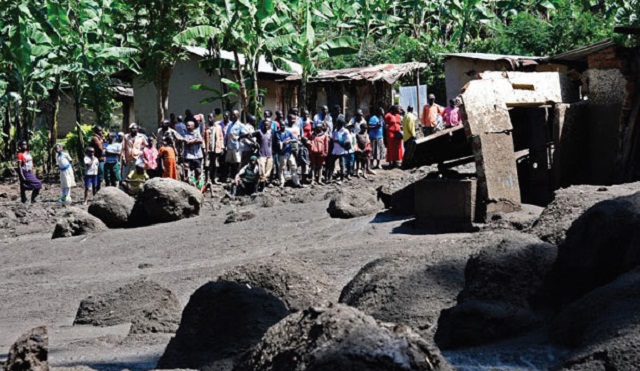
As the rescue effort raged, Khainza was afraid a makeshift bridge which had been quickly put together to transfer patients from the health centre was not safe. “It is too narrow and slippery; we may end up injuring the patients more.”
More landslides expected
According to experts, Mt. Elgon was millions of years ago higher that Mt. Kilimanjaro which today is considered the highest mountain in East Africa. However, Mt. Elgon’s height has been gradually but consistently been undercut by landslides – and it is not about to stop soon.
According to some reports, there have been up to 67 landslides in Bududa so far this year – that is about six landslides per month. People die in many of them and property, including farms of banana, coffee, and vegetables are ruined.
Apparently, when it rains, most of this rain is soaked in by the unstable mix of thick and sticky volcanic red soils and brownish sandy soils in the area. The stage for tragedy is set because this area sits on parent rock which is very near to the surface. That is a bad combination.
The slopes in Bukalasi are not the steepest but the area sits high up, at 4,600ft above sea level in the Mt. Elgon area of eastern Uganda’s border with Kenya while most of Uganda is at 3,600ft and gravity easily applies – pulling everything down.
Bukalasi properly sits at the extreme south-east tip of the district, right at the edge of the mountain. In reality, it is as if people here park their lives down the slope of the mountain without any breaks on. So it does not surprise experts that the clay sometimes combines with masses of rock and weathered debris as it rolls down in a muddy porridge that spreads mayhem, destruction, and death.
In 2010, Bukalasi sub-county witnessed the worst landslide disaster on record in Uganda. Up to 365 people perished when mud, rock boulders and debris rolled down on Nametsi village in the same area.
Failed relocation
When President Yoweri Museveni visited the area on Oct.14 after the latest disaster, he reminded residents of the shadow of death that hangs over them.
“In 2010 I told you to relocate but you thought I was telling lies,” he said; “I think you now know that I was telling the truth.” He advised residents to agree to be relocated. But that is unlikely to happen. According to some analysts, this is mainly because of two interrelated reasons; first, the government rarely fulfills pledges it makes whenever disaster strikes, and two, residents do not trust the government.
After the 2010 disaster, the government failed to relocate people immediately. It relocated the first 600 families who were relocated four years later in 2014 and moreover in Kiryandongo, which is over 300kms away. The project suffered further setbacks as most of those relocated returned to their homes in Bukalasi. Then the government released up to Shs8 billion to buy 2,828 acres of land in nearby Bulambuli district for about 5,000 displaced families. But ownership wrangles erupted and people have never been relocated. Now the government says it has resolved the wrangles and it is ready to relocate people soon.
 The Independent Uganda: You get the Truth we Pay the Price
The Independent Uganda: You get the Truth we Pay the Price


